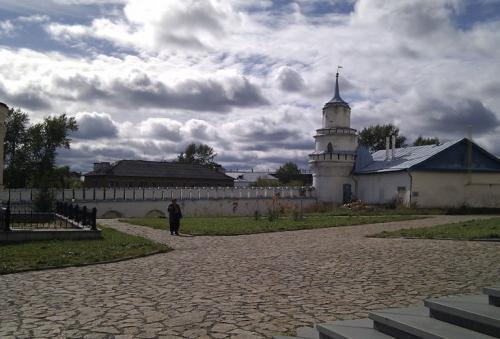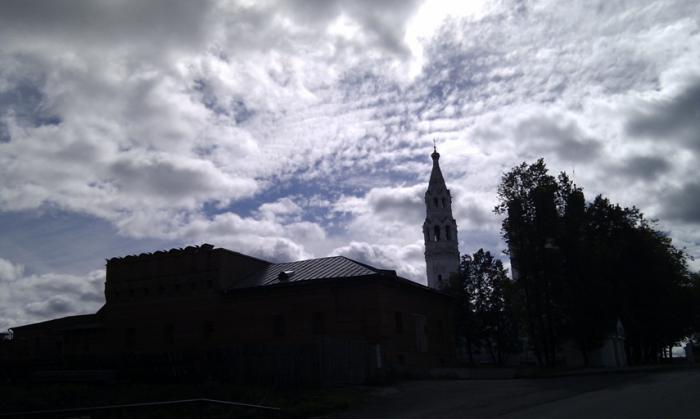The Siberian city of Verkhoturye, located on the banks of the Tura River, several centuries ago was perhaps the largest settlement of the Russian kingdom in the Trans-Urals region. At the end of the sixteenth century Yekaterinburg did not exist yet, Demidov's plants were not built, and Verkhoturye already existed. Verkhotursk customs worked in the city at that time, and it was a center of trade with the peoples inhabiting Eastern Siberia. Today Verkhoturye is the spiritual capital of the Urals, thanks to several religious institutions visited by many pilgrims.
The archbishop went to meet the requests of the old women and the ladies
The convent in Verkhoturye is the first monastery for the fair sex, established behind the Ural Range. It is believed that the year of its foundation is 1621, when the archbishop of the Siberian Diocese of Cyprian, traveling from Moscow to Tobolsk, spent four days in the city and learned that many secular ladies and old women are in search of a monastic life. After a meeting with the city governor, Vladyka decided to build a church in honor of the Protection of the Most Holy Theotokos and several cells, in which about ten women initially began to dwell. It was in honor of this church that it received the name Pokrovsky Monastery. Verkhoturye did not have its own female monastery for long enough - in 1764 this church institution was abolished and for many decades the old buildings were empty, gradually collapsing until the last decades, when restoration programs appeared.
Not the entire monastery is accessible for visiting
Today the convent in Verkhoturye is active. This is a small neat building of snow-white color with silver domes of the Intercession Church, which is available for visiting. The rest of the monastery is closed. On the territory of the temple are the relics of Kozma Verkhotursky, which many pilgrims come to bow to. This famous Ural fool was lame and walked on crutches. From an early age he accepted the feat of foolishness, went to all church services, including leaving to pray from home at night. His death dates back to 1680, when he was buried in the fence of the Verkhotursky Cathedral.
His prayer changed the weight of the precious burden
After death, the blessed one appeared in a dream with a widow asking “to cover the grave with cattle” and the woman arranged a chapel over the burial. In addition, Kozma is credited with participating in the transfer of the relics of Simeon Verkhotursky, during which the holy fool allegedly asked the saint to stop the transfer, since his legs hurt and were tired, and people were forced to put the burden on the ground, since it became too heavy. After Kozma rested, the procession continued to move, and at the place of the stop, they placed the Holy Kosminskaya empty. How to find a female monastery in Verkhoturye? The monastery is located downstream from the city Kremlin and there are no signs to it, as tourists say, so local residents need to find out how to get there. Finding a building will not be difficult, since the city itself is small, about 7.5 thousand people live in it, and all the attractions are within walking distance.
The smallest Kremlin in Russia
Pilgrims consider it necessary and interesting to visit the Verkhotursky Kremlin, the smallest Kremlin in Russia. On its territory is the Trinity Cathedral, dating from the beginning of the 18th century. This building is remarkable for hours on the bell tower of the cathedral, a cast-iron floor that allows you to keep cool indoors even in the heat, and overlooks the city suspension bridge over the river. What else is the city of Verkhoturye interesting for? The monastery for males, founded in 1604 by a native of Poshekhonye, hieromonk Ionoy, is known for its large area, which exceeds the area of the Kremlin in Moscow.
A coffin with an imperishable body rose from the grave
A hundred years after its founding in Verkhoturye, the St. Nicholas Monastery found the relics of St. Simeon, who is revered as the patron saint of the Ural lands. This man was born in wealth and nobility, but in the Time of Troubles he left his family and home, located in the European part of the Russian Empire, in the Urals, where he settled in the village of Merkushino. Here he hid his origin and lived as a simple peasant, embodying the Christian feat of “forgiveness”. Simeon attended a local church, secluded himself for prayers, sewed fur coats for the peasants, without charging a fee, and preached to the local Vogul tribes. Fifty years after his death in 1692, a coffin with an imperishable body Simeon rose from the grave, and many people suffering from skin diseases were healed from his grave. Two years later, the relics were examined and transferred to the Nikolaev temple.
The relics of the saint were not subject to fire
What other miracles happened in Verkhoturye? The monastery, on the territory of which the relics of the saint appeared, was burned in 1716 in a fire, and the church, where the remains of Simeon were located, was completely destroyed, but the cancer was not miraculously affected. In 1838 the temple was restored and the ark with relics was placed in its aisle. In addition, the place of worship is the burial place of Simeon Verkhotursky in his native village of Merkushino, where a spring was hammered from the grave, over which a chapel was erected, first wooden, then stone. Righteous Simeon left an indelible impression on the souls of people, so at the end of the 19th century the Brotherhood of St. Simeon appeared in Yekaterinburg, which was engaged in spiritual enlightenment, as well as supporting disadvantaged people. The relics of Simeon attracted many pilgrims, the number of which was estimated at tens of thousands a year, so the monastery in Verkhoturye underwent significant architectural changes to accept everyone.

Five thousand people can pray in this cathedral
The main cathedral of the monastery, Krestovozdvizhensky, was founded in early 1905 and accommodates about 5 thousand people. It is one of the largest cathedrals in Russia along with St. Isaac's and the Cathedral of Christ the Savior. The religious building was erected for 8 years and has a seven-headed design in combination with four tower belfries. Before the revolution, the church was decorated with 64 icons, an earthenware iconostasis, German tiles on the floor, and cast-iron screw elements. There are 137 windows in the temple, which is twice as many as in the Cathedral of Christ the Savior in Moscow, and its altar, thirty meters high, leaves an unforgettable impression on visitors. What was the fate of this religious building during the years of Soviet rule in Verkhoturye? The monastery after the 30s. used for household needs. On the territory of the temple there was a cinema hall, a warehouse of building materials, and a department of the colony for minors. The revival of religious buildings began only in the 90s of the twentieth century.

All the churches of the monastery in Verkhoturye
Verkhoturye, whose St. Nicholas Monastery has more than one church, demonstrates the variety of architectural styles that prevailed in religious buildings in Russia at one time or another. For example, the Simeon-Annen Church, located above the gate (gate), was laid in the mid 18th century and was built in the “Asian” style in the form of a two-story tetrahedron. The temple has a two-tiered iconostasis, and the decoration is close to the Russian style and classicism. Today, the building is considered to be of little capacity and secondary, therefore liturgies are rarely served there and therefore access to it is limited.

Those who wish to visit Verkhoturye, a monastery whose photos are presented here, can not always provide access to the Church of St. Nicholas the Wonderworker, built on the site of the once-existing large church. The original building, erected in 1712, was destroyed in 1936, and in its place in 2000 a new church was built in the name of the same saint, where liturgies are held periodically. The time of their holding should be clarified with the brethren of the monastery. But for those who come to worship the Transfiguration of the Lord in Verkhoturye, the male monastery provides the opportunity to do this daily in the eponymous church, built in 1821 and underwent little changes. In addition to religious institutions, Verkhoturye is interesting for well-preserved examples of ancient architecture, a museum of local lore, as well as a peaceful and quiet atmosphere favorable for relaxation, which is absent today in large megacities.